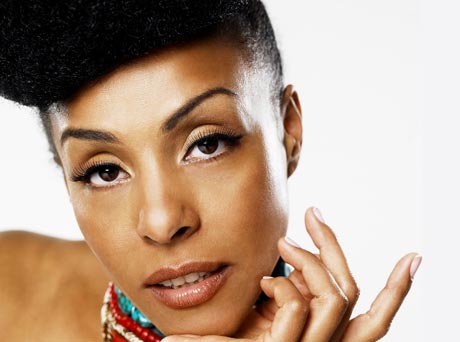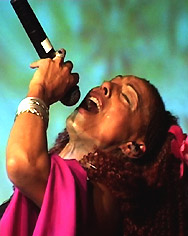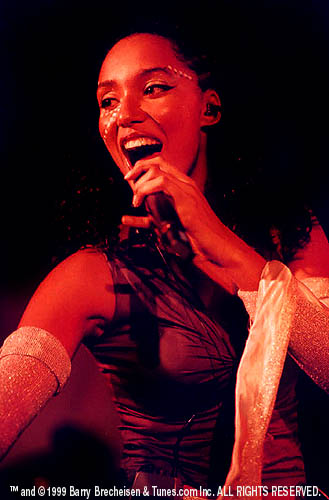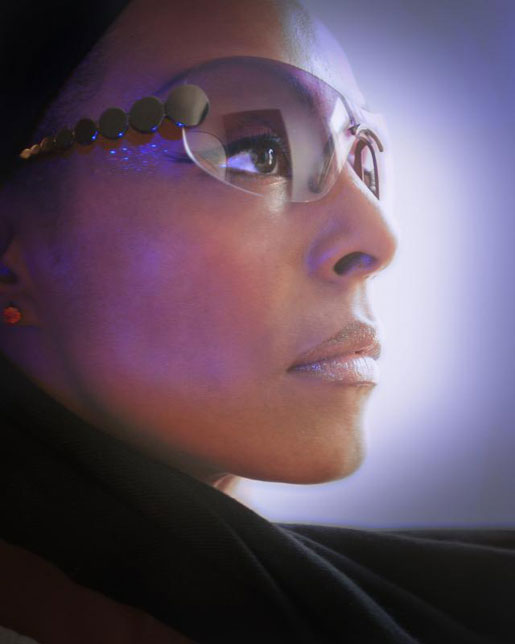ZAP MAMA / “1000 Ways”
When we left off (see the Classic post for the beginning of this story), the Zap Mama scale had begun to tip to the contemporary side of things. They’d begun as a five-piece all a capella singing group. Then, over the course of thirteen years and five albums they’d evolved into what was essentially a one-woman band augmented by guest appearances from friends, collaborators and hired hands. We were also tracking the cover art of Zap Mama’s albums, art which had evolved from a group photo of five women as equals to a head-and-shoulders shot of Marie Daulne all by her lonesome.
 As you might expect, Zap Mama’s new album Supermoon ups the ante in both areas. The music is more contemporary-sounding than ever and the cover art is so Marie-focused that it’s almost weird. The conceit of the title is that Marie doesn’t consider herself a ‘superstar,’ but rather a ‘supermoon.’ Presumably, this isn’t just because a moon is a smaller, less ‘self-important’ entity than a star, but also because the moon often represents the feminine. I happen to like the imagery. As is the case with Marie’s best songwriting, it’s playful yet meaningful. What I don’t like is the cover art. I don’t know what they were going for but it appears that an attempt was made to use Marie’s face as a visual metaphor for an actual stellar body. A moon, I guess. The shot is so close we can’t see anything above her hairline or below her chin. It’s just a giant Marie face coming right at you like POW!
The other strange thing is the makeup. Marie looks like she’s fresh out of one of those glamour shot studios in the Westwood Mall or something. She always wore makeup, but it used to be colorful, odd-looking makeup (by American standards anyway). I don’t know if Marie’s earlier style of face painting was based on actual cultural traditions, but it looked like it could have been. Then again, I suppose the American glamour shot look—heavy mascara, eye-shadow and eyeliner, sculpted brows, glossy lip appliqué—is a cultural tradition too. Just not one I’d associate with a half Belgian/half Bantu warrior-woman like Marie. Likewise for the ‘sexy’ photos of Marie in the inside of the CD jacket. Never thought I’d see her rocking the high-heel pumps look, but there you have it.
So what about the music? I have mixed feelings. On the plus side, there are pieces like this week’s feature track “1000 Ways.” It’s a lively bit of Deee Lite-ish/post-Prince funk so infectious it’s hard to listen to it without smiling. Marie’s vocals remain as instantly recognizable and enjoyable as ever. Her slightly hoarse and lightly-accented singing voice remains one of my favorite musical sounds, period. It helps too that Tony Allen is on the drums. (Tony is the guest percussionist on this one track only.) His trademark double and triple snare drops help to anchor the lightness of the breezy melody and backing vocals.
Another high point is the title track “Supermoon.” The way I hear it, it’s the closest Marie’s ever come to a standard Western pop song. But in this case, that’s not a criticism. Both in execution (effortlessly flawless) and sentiment (“Am I / You are / Are you / I am a Supermoon”) the song is gorgeous. An Amazon reviewer said the tune is reminiscent of Macy Gray. That’s a good call. I wouldn’t have thought of it, but the big chorus and inescapable hook will definitely remind you of a good Macy moment.
There are a few other likeable songs too, but especially in the second half, the album begins to sound thin and rather lifeless. One of the problems may be a lack of cohesion. The CD booklet lists an astonishing number of collaborators (46 to be exact), recording studios (four) and engineering/production teams (nine). On paper, it looks like a haphazard, patchwork affair and at times it sounds like it as well. I hate to pit Zap Mama present against Zap Mama past—it’s probably not fair—but some of the tunes on Supermoon do indeed come off like pale imitations of earlier Zap Mama music. If it wasn’t Marie herself at work, I’d say she should probably sue.
If you’ve read everything I’ve written so far about the evolution of Zap Mama, you’re probably left with the impression that I’m saying groups are great and soloists are bad. That’s not my point at all. I can name many musicians who created their best music essentially on their own. (Three quick ones: Prince, Stevie Wonder, Shuggie Otis.) But in the case of Zap Mama/Marie Daulne, it seems that they/she was best when there was a mix of the group dynamic with solo leadership as well as a mix of traditional singing and song-crafting with contemporary sounds and techniques.
Listen to all six albums and I doubt you’ll hear Zap Mama’s music as having peaked at the beginning and devolving from there. So far, I’d consider it an arc. They began as a beautiful-sounding if sometimes unfocused ensemble and have become a slick-sounding and very Marie-focused solo act. The sweet spot was the middle of that arc, when both the music and the imagery achieved an equilibrium between new and old, group and solo, hard and soft, etc. I’m going to keep listening to Zap Mama and I’m going to keep supporting Marie Daulne, but I’m also going to be rooting for a return to the balance.
As you might expect, Zap Mama’s new album Supermoon ups the ante in both areas. The music is more contemporary-sounding than ever and the cover art is so Marie-focused that it’s almost weird. The conceit of the title is that Marie doesn’t consider herself a ‘superstar,’ but rather a ‘supermoon.’ Presumably, this isn’t just because a moon is a smaller, less ‘self-important’ entity than a star, but also because the moon often represents the feminine. I happen to like the imagery. As is the case with Marie’s best songwriting, it’s playful yet meaningful. What I don’t like is the cover art. I don’t know what they were going for but it appears that an attempt was made to use Marie’s face as a visual metaphor for an actual stellar body. A moon, I guess. The shot is so close we can’t see anything above her hairline or below her chin. It’s just a giant Marie face coming right at you like POW!
The other strange thing is the makeup. Marie looks like she’s fresh out of one of those glamour shot studios in the Westwood Mall or something. She always wore makeup, but it used to be colorful, odd-looking makeup (by American standards anyway). I don’t know if Marie’s earlier style of face painting was based on actual cultural traditions, but it looked like it could have been. Then again, I suppose the American glamour shot look—heavy mascara, eye-shadow and eyeliner, sculpted brows, glossy lip appliqué—is a cultural tradition too. Just not one I’d associate with a half Belgian/half Bantu warrior-woman like Marie. Likewise for the ‘sexy’ photos of Marie in the inside of the CD jacket. Never thought I’d see her rocking the high-heel pumps look, but there you have it.
So what about the music? I have mixed feelings. On the plus side, there are pieces like this week’s feature track “1000 Ways.” It’s a lively bit of Deee Lite-ish/post-Prince funk so infectious it’s hard to listen to it without smiling. Marie’s vocals remain as instantly recognizable and enjoyable as ever. Her slightly hoarse and lightly-accented singing voice remains one of my favorite musical sounds, period. It helps too that Tony Allen is on the drums. (Tony is the guest percussionist on this one track only.) His trademark double and triple snare drops help to anchor the lightness of the breezy melody and backing vocals.
Another high point is the title track “Supermoon.” The way I hear it, it’s the closest Marie’s ever come to a standard Western pop song. But in this case, that’s not a criticism. Both in execution (effortlessly flawless) and sentiment (“Am I / You are / Are you / I am a Supermoon”) the song is gorgeous. An Amazon reviewer said the tune is reminiscent of Macy Gray. That’s a good call. I wouldn’t have thought of it, but the big chorus and inescapable hook will definitely remind you of a good Macy moment.
There are a few other likeable songs too, but especially in the second half, the album begins to sound thin and rather lifeless. One of the problems may be a lack of cohesion. The CD booklet lists an astonishing number of collaborators (46 to be exact), recording studios (four) and engineering/production teams (nine). On paper, it looks like a haphazard, patchwork affair and at times it sounds like it as well. I hate to pit Zap Mama present against Zap Mama past—it’s probably not fair—but some of the tunes on Supermoon do indeed come off like pale imitations of earlier Zap Mama music. If it wasn’t Marie herself at work, I’d say she should probably sue.
If you’ve read everything I’ve written so far about the evolution of Zap Mama, you’re probably left with the impression that I’m saying groups are great and soloists are bad. That’s not my point at all. I can name many musicians who created their best music essentially on their own. (Three quick ones: Prince, Stevie Wonder, Shuggie Otis.) But in the case of Zap Mama/Marie Daulne, it seems that they/she was best when there was a mix of the group dynamic with solo leadership as well as a mix of traditional singing and song-crafting with contemporary sounds and techniques.
Listen to all six albums and I doubt you’ll hear Zap Mama’s music as having peaked at the beginning and devolving from there. So far, I’d consider it an arc. They began as a beautiful-sounding if sometimes unfocused ensemble and have become a slick-sounding and very Marie-focused solo act. The sweet spot was the middle of that arc, when both the music and the imagery achieved an equilibrium between new and old, group and solo, hard and soft, etc. I’m going to keep listening to Zap Mama and I’m going to keep supporting Marie Daulne, but I’m also going to be rooting for a return to the balance.
 As a bonus, we’re going to drop a few live Zap Mama tracks on you. I only saw them perform once. It must’ve been in ’97 or ’98 because they were performing the songs from the 7 album. It was a fantastic show, one of the best live shows I’ve ever seen. It was obvious that Marie was the leader and the central focus of the band, but there was definitely a band dynamic going on. All five vocalists (and I don’t know how many if any of the other four were original members) had moments when they sang lead or were at the center of the stage. The instrumentalists were very good too. I consider it a mark of musical integrity when an artist sounds as good live as they do on record. If they sounded any different at all, Zap Mama sounded better.
All of the live tracks in the jukebox are taken from Los Angeles radio station KCRW’s Morning Becomes Eclectic show. KCRW’s usual format is acoustic, although some artists plug in keyboards or electric bass or whatever. These tracks will give you an idea of what Zap Mama sounds like live although their plugged-in show is considerably more dynamic and intense as compared to these mostly-acoustic tracks. Both on these songs and on stage, Marie is a very comfortable, even casual performer. You never feel like you’re watching a spectacle or fantastical presentation. It’s more like hanging out in a musician’s oversized living room while she and her friends play and sing. In short, if Zap Mama ever comes to your town, go to the show! You’ll arrive back at home feeling better than when you left.
Get your contemporary Zap Mama here:
As a bonus, we’re going to drop a few live Zap Mama tracks on you. I only saw them perform once. It must’ve been in ’97 or ’98 because they were performing the songs from the 7 album. It was a fantastic show, one of the best live shows I’ve ever seen. It was obvious that Marie was the leader and the central focus of the band, but there was definitely a band dynamic going on. All five vocalists (and I don’t know how many if any of the other four were original members) had moments when they sang lead or were at the center of the stage. The instrumentalists were very good too. I consider it a mark of musical integrity when an artist sounds as good live as they do on record. If they sounded any different at all, Zap Mama sounded better.
All of the live tracks in the jukebox are taken from Los Angeles radio station KCRW’s Morning Becomes Eclectic show. KCRW’s usual format is acoustic, although some artists plug in keyboards or electric bass or whatever. These tracks will give you an idea of what Zap Mama sounds like live although their plugged-in show is considerably more dynamic and intense as compared to these mostly-acoustic tracks. Both on these songs and on stage, Marie is a very comfortable, even casual performer. You never feel like you’re watching a spectacle or fantastical presentation. It’s more like hanging out in a musician’s oversized living room while she and her friends play and sing. In short, if Zap Mama ever comes to your town, go to the show! You’ll arrive back at home feeling better than when you left.
Get your contemporary Zap Mama here:
- From Ancestry In Progress (Luaka Bop/Warner Bros, 2007): “Bandy, Bandy” and "Ça Varie"
- From Supermoon (Heads Up, 2007): “1000 Ways,” “Supermoon” and “Go Boy”
- From Live At KCRW (Promo only, 2004): “African Sunset” (originally from 7) and “Yelling Away”Ancestry In Progress)
- From Live At KCRW (Promo only, 2007): “Affection” (originally from Supermoon) and interview segment with host Nic Harcourt (Marie talking about the recording process for Supermoon and guest appearances by Tony Allen and Meshell, among others)

“I’m a nomad. I like to discover my sound with different instruments, different genres. For me it’s normal. My name is Zap Mama – it’s easy to understand that it’s easy for me to zap in from one instrument to another, a culture, a style. I’m more a citizen of the world, not an American or Belgian. … I can have very, very close friends in the United States and have neighbors I have nothing to do with. I’m not nationalist.” —Zap MamaFROM. The record is not clear. Conflicting reports abound. Marie Daulne was born in 1964 somewhere in the Democratic Republic of the Congo (now known as Zaire), the fourth child of a Bantu mother, Bernadette Aningi, and a French-speaking, Belgian father Cyrille Daulne. Her father was killed by Simba rebels who were opposed to the European presence in Africa. Some reports say Marie’s father died before she was born, some say after. Some reports say that Marie was born in the interior, others that she was born in the town of Isiro. Marie’s mother fled to the interior among the people generally known as Pygmies who sheltered them until the small family was eventually airlifted to Belgium where her father’s family, although unaware of their existence before the arrival, embraced and supported their son’s wife and childen. Marie Daulne does not specifically remember her infancy in the Congo but does remember her mother singing around the house. Paradoxically, her mother encouraged Marie to assimilate and to excel at French and in her academics.
What I know that I learned from my mother is to be strong and to stay positive in any kind of situation; that's the best weapon to survive. That's what I learned, and this is the main message I pass into my music. —Zap MamaAn injury while a teenager forced Marie to give up sports and dance. Eventually she turned to music. She lisrtened to the radio and initially was heavily influenced by jazz and blues.
The first music I really listened to, apart from the radio, was jazz—Billie Holiday, Ella Fitzgerald. When I was growing up, there weren't many black people in Europe—my family was alone. Then I saw an American musical comedy with black people on TV. And I couldn't believe it. I said, "That's us!" My whole fantasy life was based on that movie. It was an old black-and-white film—I didn't understand any of it, but there were songs by Billie Holiday and Ella Fitzgerald. I recorded the sound with a cassette recorder and listened to it in my bed every night. The tape broke and I glued it back together. —Zap Mama
 TOWARD. What kind of music does a forty-year old aspire to create, especially within an industry that is fixated on youth?
I am waiting to hear the future according to Zap Mama. There is too much history there, too many years invested in roots music, invested in acoustic performance, invested in African musical heritages for Zap Mama to genuinely end up as a hip-hop act. Indeed, exclusively practicing hip-hop would be an exactly that: an act!
I have added a few one-off projects to the jukebox including a version of "Iko Iko" done up soca stylee. (This week we have over two hours of music—enjoy, enjoy, enjoy!)
I suspect that another Zap Mama morph is just around the bend.
Zap Mama has left New York. And Philadelphia. She is back in Belgium. I suspect we are about to see the third act. Act one was a capella. Act two was contemporary music leaning toward the dance floor. Wither goest Zap Mama now?
Stay tuned… to be continued…
—Kalamu ya Salaam
TOWARD. What kind of music does a forty-year old aspire to create, especially within an industry that is fixated on youth?
I am waiting to hear the future according to Zap Mama. There is too much history there, too many years invested in roots music, invested in acoustic performance, invested in African musical heritages for Zap Mama to genuinely end up as a hip-hop act. Indeed, exclusively practicing hip-hop would be an exactly that: an act!
I have added a few one-off projects to the jukebox including a version of "Iko Iko" done up soca stylee. (This week we have over two hours of music—enjoy, enjoy, enjoy!)
I suspect that another Zap Mama morph is just around the bend.
Zap Mama has left New York. And Philadelphia. She is back in Belgium. I suspect we are about to see the third act. Act one was a capella. Act two was contemporary music leaning toward the dance floor. Wither goest Zap Mama now?
Stay tuned… to be continued…
—Kalamu ya Salaam
This entry was posted on Sunday, November 11th, 2007 at 2:42 am and is filed under Contemporary. You can follow any responses to this entry through the RSS 2.0 feed. You can leave a response, or trackback from your own site.
Leave a Reply
| top |